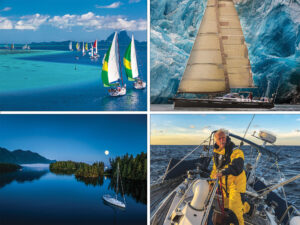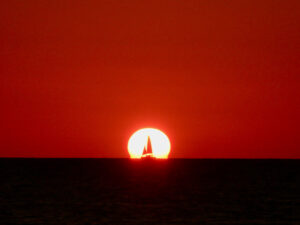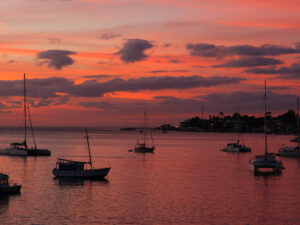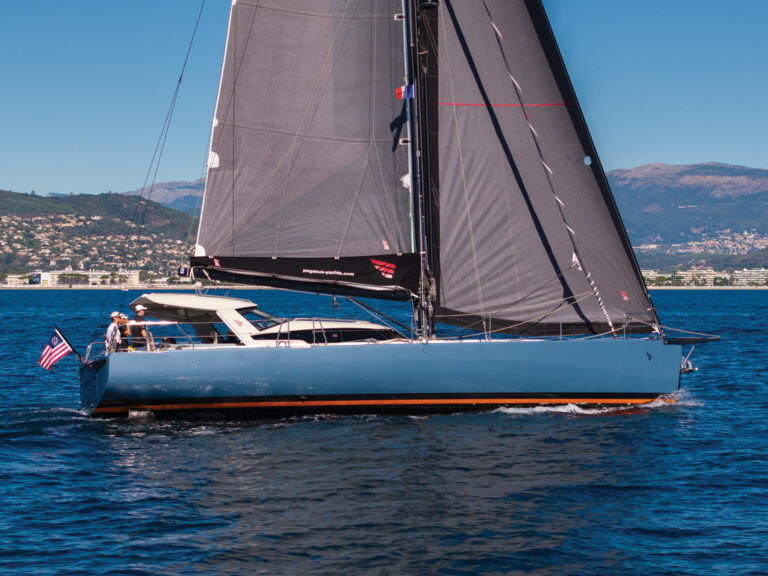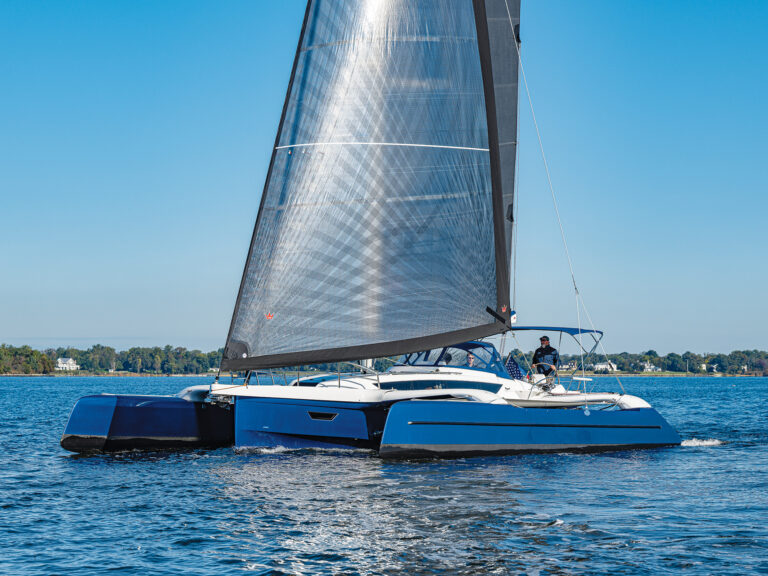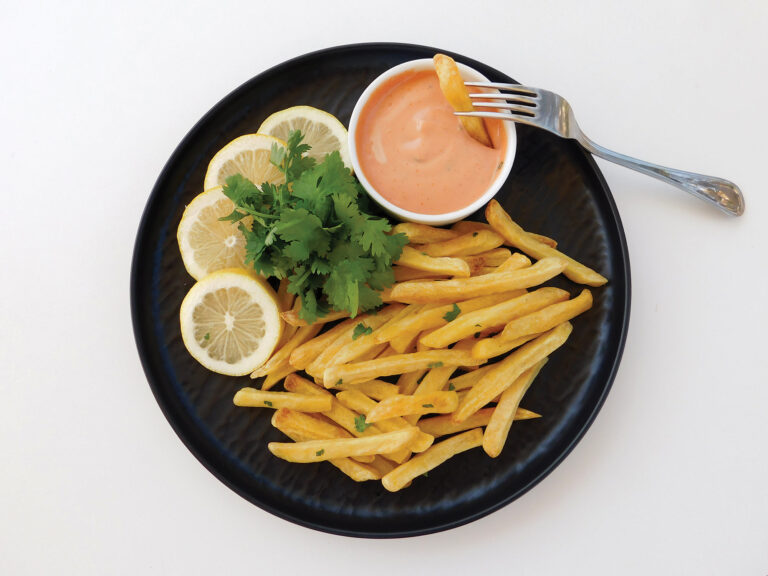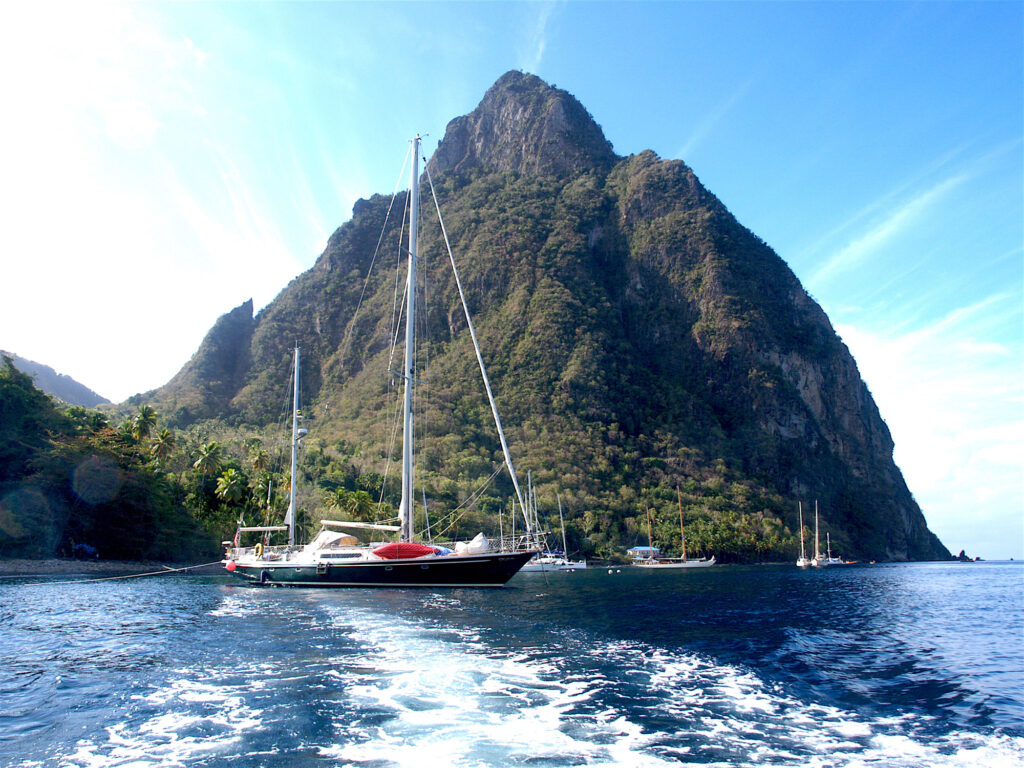
Strider, the Reliance 44 cutter I was aboard as a guest of the owner, left Bequia at midday on April 4. Our course was northbound to Chateaubelair, a village halfway up the west coast of St. Vincent. The 20 miles took us less than four hours. There was little wind as we left Admiralty Bay, but once out of Bequia’s lee, we caught a fair easterly breeze of 12 knots. With the engine off and sails up, we were making 6 knots.
Our original plan had been to hop up the chain of islands to Antigua by day, covering a distance of 250 miles and dropping the hook each night. If time allowed, we’d go ashore, clear in and spend a few days exploring. This normally requires an entire season, not the four weeks that I had—and we’d squandered two weeks hanging out on Bequia, with a side trip down to Union and Carriacou islands.
Strider’s owner and I wanted to be in Antigua for the annual Classic Yacht Regatta at the end of the month. We could make that in two days if we sailed nonstop, but why rush when there is so much to see and do on these islands?
The west side of St. Vincent has a half dozen anchorages. Neither of us had been to Chateaubelair, so we chose it and read up on the anchoring options in my 2009 copy of the Doyle Guides. The village itself is tucked in at the end of a valley that spills down from Soufriere, the towering volcano that erupted in April 2021, spreading ash over most of St. Vincent and nearby islands to the south. Since we had no need or time to go ashore, we chose an anchorage on a narrow ledge beneath the cliffs to the north of the village.
As we rounded the island south of the anchorage, we could see a few yachts already anchored along the cliff that rises 400 feet above the sea. A girl on a surfboard, with two younger kids aboard, was paddling about. We skirted them, gave a friendly wave that they returned, and watched them paddle on. An elderly fisherman in a kayak came by, towing a line. He hollered, “There’s a school of tuna here!” and then paddled on.
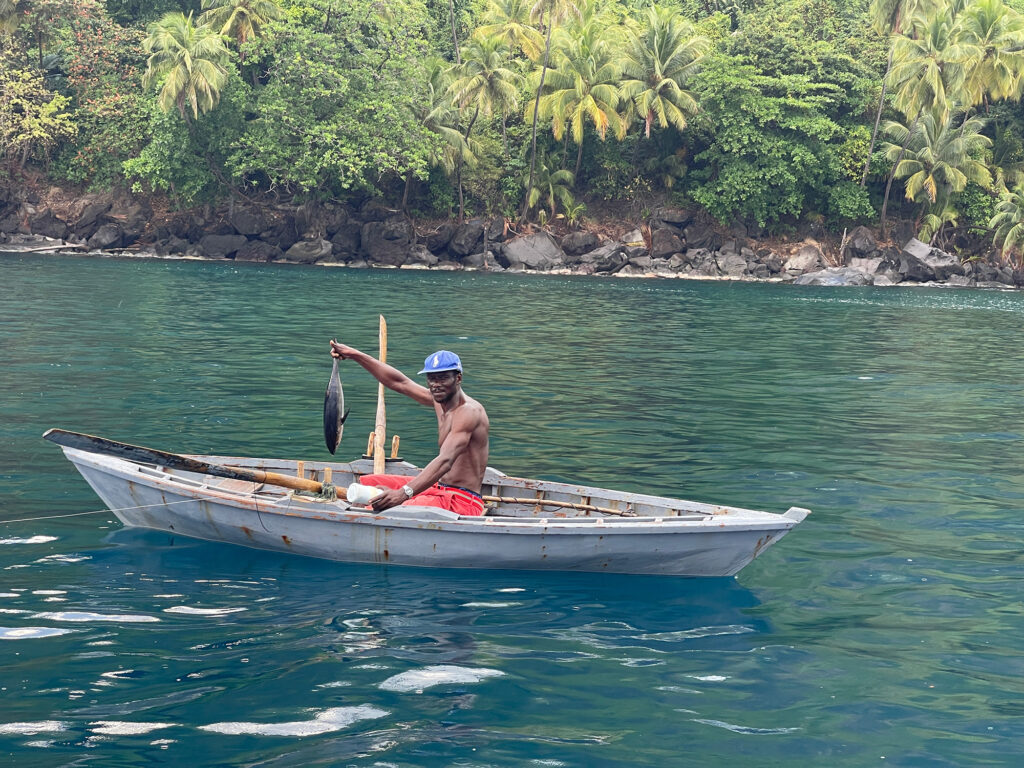
Striker’s owner, Richard, was at the helm calling off depths as we creeped in close to the palm-tree-lined cliff. I was on the foredeck, readying the anchor. At 30 feet and no more than 100 yards from shore, Richard put the engine in reverse. The boat slowed to a stop, and I released the anchor and began to play out the chain.
Once the anchor was on the bottom, I let out another 100 feet, deployed the chain brake, climbed out over the bow rail, and put my foot on the chain. This is my standard operating procedure. I can feel the chain vibrate as the slack plays out along the rocky bottom.
The chain tightened, rose and jumped. I could feel the anchor skip, reset, skip again, set and stay put. Richard gave the boat another nudge astern. The anchor chain raised up in a straight line. The boat stopped. We were here.
I rigged the snubbing line, let out another few feet of chain to hang slack over the bow roller, and headed back to the cockpit. It was time for rum. Richard prefers punch; I’m an “add tonic” guy.
As we were settling into the cockpit, a gunmetal gray catamaran charged into the anchorage at 6 knots, narrowly missing the kids on the surfboard and passing over the fisherman’s trolling line.
“That Frenchman has no regard,” Richard said, setting down his drink and heading forward.
“How do you know he’s a Frenchman?” I asked.
“Look at the flag. Besides, who else would be so arrogant?”
The offending catamaran slowed to a stop just ahead of us. Richard began—nicely, I thought—advising the chap on board that there were kids about and that he’d run over the fisherman’s line.
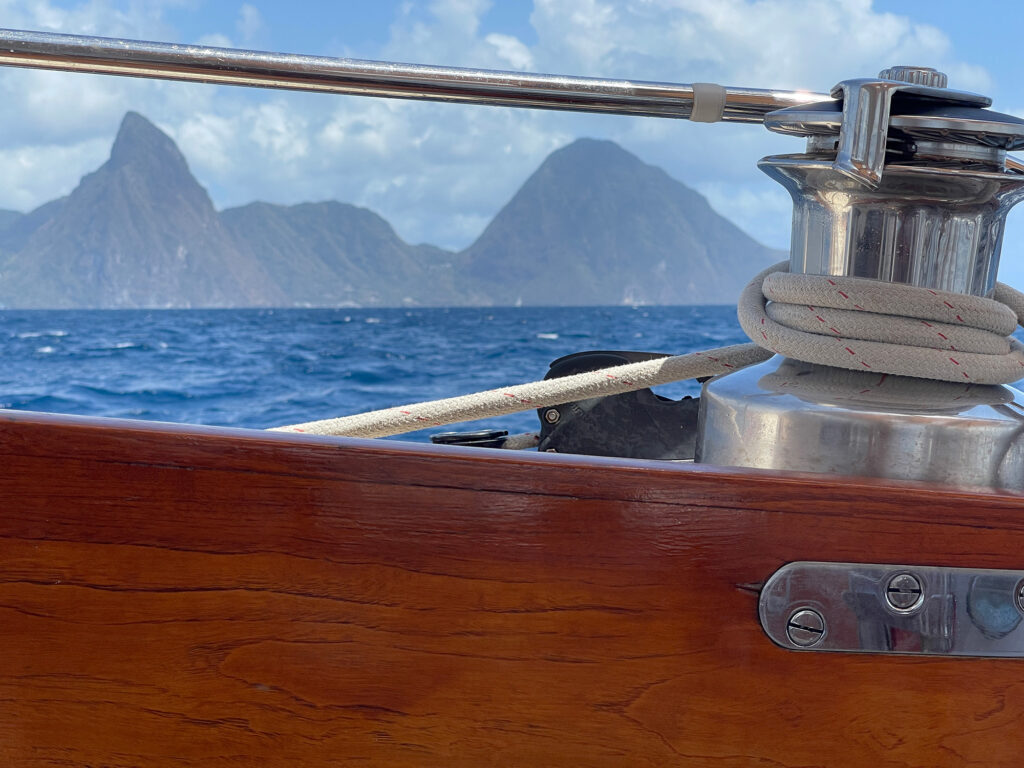
The man in charge, in French-accented English, replied, “Who are you talking to? Me? Who are you to tell me what to do?”
“Have a little respect for the people that live here,” Richard said.
“You are trying to disrespect me,” the Frenchman replied, adding a string of words that are best not printed here.
The argument continued for another minute, until the Frenchman became preoccupied with his anchoring. Two things worried me: the catamaran’s proximity and the chap’s anchoring methods.
As it turned out, what I should have been worried about was noise. Richard’s admonishments resulted in loud music playing all night from the catamaran’s aft deck.
April 5
We got underway at first light, motorsailing north along St. Vincent’s wilderness coast. Clouds obscured the summit of Soufriere, yet shafts of sunlight darted in and out of those clouds, spilling down valleys that descended to the sea. The entire northwest coast of the island was a rugged wilderness with no sign of man’s intrusion.
A northeast wind began to fill in as we approached the north tip of the island, motorsailing with a fully reefed main and a bit of the jib unrolled. As anticipated, the wind began in gusts, to 30 knots with seas on the bow. It’s the island effect, bending the prevailing trade wind and seas. We sheeted in and fell off to the northwest as conditions worsened. There was spray over the bow. Water filled the scuppers. For a while, it was a rough ride.
By 9:30, things had settled down. The seas and wind were east at 15 to 18 knots on the beam. We unrolled the main, kept the jib short and charged along at nearly 7 knots on course for the Pitons of St. Lucia, already visible 20 miles ahead.
It’s delightful out here, between the islands. Atlantic swells are on the beam, wind chop ruffles the sea’s surface, and the view is of blue sky with popcorn clouds far off on the horizon. It’s trade-wind sailing at its best.
One of the charms of this chain is that the islands are strung out north to south in a gentle, 400-mile arch. With the trades blowing easterly (maybe a bit northeast, sometimes a bit southeast for much of the year) it’s a beam reach from Grenada to Antigua. From there, the wind will be on the starboard quarter as you make your way up to Sint Maarten, and all the way up to the British Virgin Islands. At times like this, you wish the sailing could go on forever.
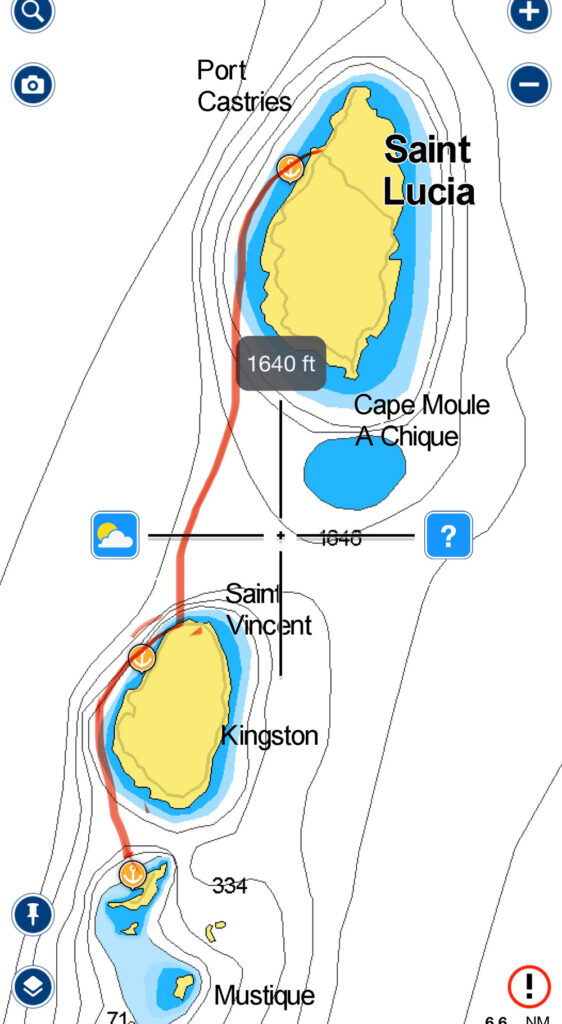
Around noon, a 350-foot tanker with a black hull passed close astern. By 1 p.m., the wind began to move into the southeast, and by 2 we were back motorsailing in St. Lucia’s wind shadow.
But by now, we were 3.5 miles west of the Pitons, too far out to stop for the night. I was sad, because there is a special anchorage below the northernmost pinnacle. My family and I spent four days anchored there in 2010. Anchoring is tricky, as the bottom falls off precipitously, requiring a stern line run ashore to a boulder or tree. A bunch of kids are usually there to help, for a few local dollars. It’s a short dinghy ride into the village, where there is an open-air market stocked by farmers. Guides and taxi drivers will bring you up the hill to hike or slip into the hot mud pools.
We gave all of that a pass and continued north to St. Lucia’s Rodney Bay.
Richard was restless. Something was bothering him.
“The engine is too hot,” he said, looking at the gauges before heading below.
The only way to shut down Striker’s diesel engine is to open the hatch in the cabin sole and manually pull the fuel shutoff. The pushbutton on the engine’s control panel is inoperative, one of those small details that Richard has not gotten around to fixing.
“I think we may have some sargassum weed in the raw-water strainer!” he hollered from deep in the engine room.
Richard reached down in the bilge and closed the through-hull fitting that feeds seawater to the engine’s heat exchanger. The strainer is a stainless steel mesh basket inside a brass-and-glass fitting. Richard unscrewed the housing, removed the basket and found a few strands of seagrass. He put the strainer back together and opened the seacock.
Within 10 minutes, we were back under power, motorsailing up the west coast of St. Lucia. We passed along the island’s west coast, the inlet of Marigot, and Castries. Finally, we reached Rodney Bay, just north of the entrance channel leading into the IGY Marina complex.
Richard went below to shut down the engine, only to discover the engine room partially flooded and the Balmar alternator half submerged.
The raw-water strainer was the culprit. After Richard’s inspection, the lid was improperly seated.
Now what? A brainstorming session in the cockpit.
This boat—like all boats—is electrically dependent. There’s the bilge and fresh-water pumps, refrigeration, the windlass, the autopilot, nav lights, radios, navigation instruments, phone chargers… We had enough juice in the batteries for a day or two if we conserved power. The engine would run without electricity once it started. We could sail. We could hand-steer. And we were anchored off Rodney Bay, one of the Caribbean’s largest marine centers. There had to be someone ashore who could fix the water-soaked alternator.
I opened the Doyle Guides app on my phone, and found Regis Electronics nearby. We now had a game plan for the next morning. We also had a backup. Richard is a resourceful mariner, so he had a spare alternator aboard. He’d retained the factory-installed alternator when he added the higher-output Balmar.
That next morning, while Richard was clearing us in, I went exploring. The inner harbor of Rodney Bay has hints of Fort Lauderdale, with condos and motoryachts. The IGY Marina complex is huge, with floating docks hosting charter fleets, powerboats and transients. Shops and boutiques are all around, including a gelato shop my kids couldn’t stay away from when we were here last.
It took Richard a good hour to clear in. “There was a line,” he said, joining me at a table in the shade near the dinghy dock. From there, we took the alternator to the shop. It was fried. Not fixable.
Back in the shade, Richard called Hamilton Marine, our favorite chandlery in Maine. He knew the alternator guy, and the store had an exact replacement on the shelf. They could ship it down. Richard called a friend in Maine who was planning to join him when we reached Antigua. He asked if she could bring it down with her.
With that problem solved, we headed back out to the boat for lunch. Then, Richard installed the original alternator.
We needed a few things, so back into the lagoon we went. We found the supermarket and stocked up for a few days.
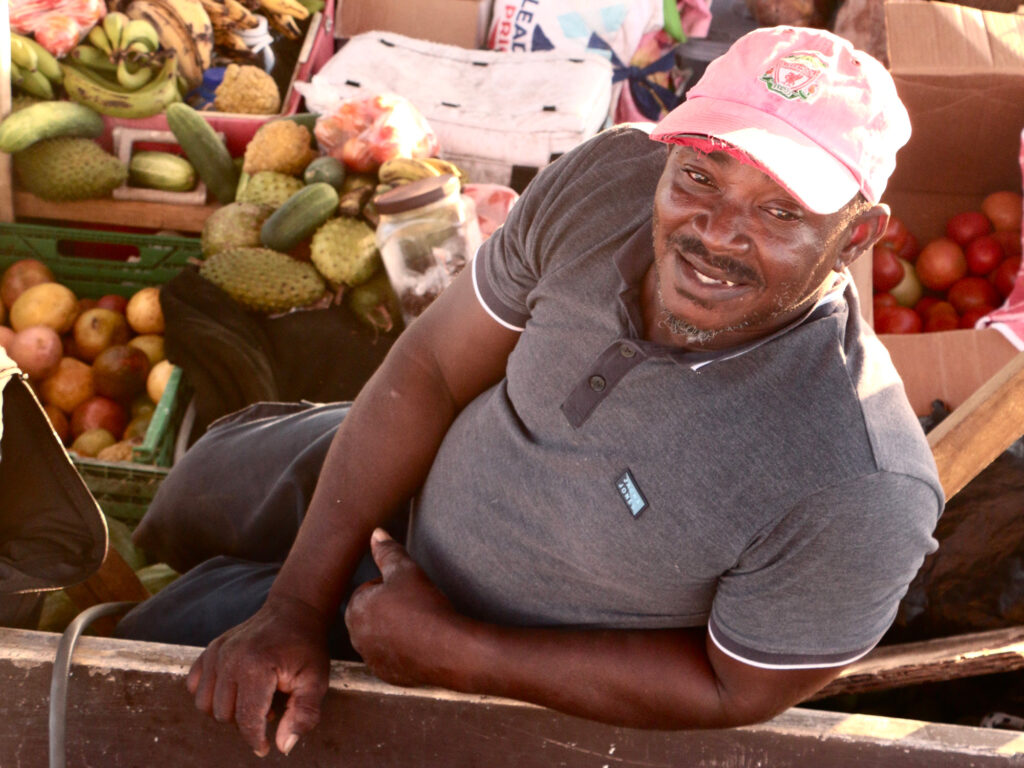
Late afternoon, about rum time, a guy named Gregory came by the boat for a chat in his floating farmers’ market. I remembered him from years ago, with his baskets of fruits and vegetables, all under a palm-thatched awning. He sold us a loaf of his daughter’s banana bread.
The next morning, with the engine purring below, we raised the anchor and prepared to get underway. Richard increased the revs to 2,000 rpm, and then the alternator belt screamed.
We looked at each other. Now what?

